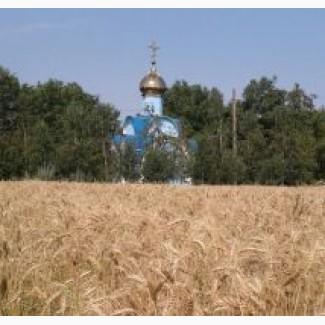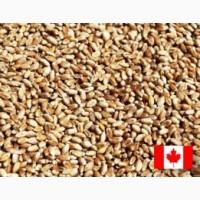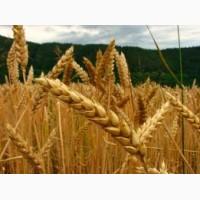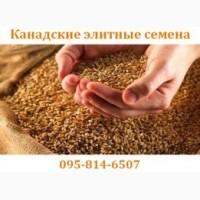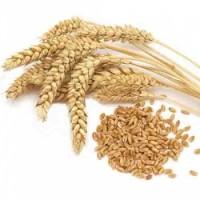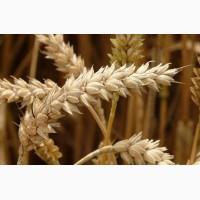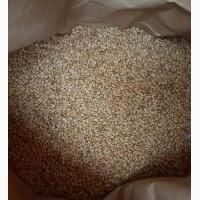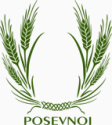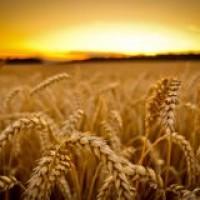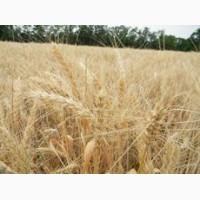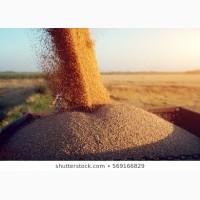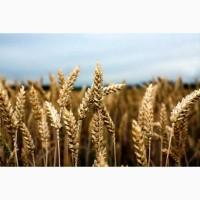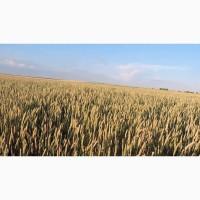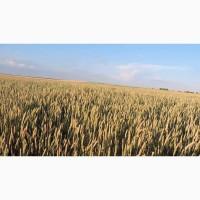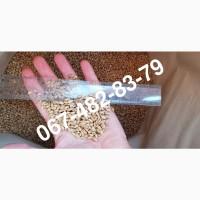Sell / buy
Sell URGENT wheat seeds two-handled AMADEO Canadian transgenic variety, Poltava region.
Price|| |14055 UAH. / kg
Region:all of Ukraine,
Poltava region.
(City of Poltava)
Updated:
Grain destination: Sowing material
Quantity: 20,000 tons
Soft wheat ( Triticum aestivum. ) Wheat is a genus of herbaceous, mostly annual plants of the bluegrass family, providing almost 30% of world grain production and supplies more than half of the world's population with food. Flour is made from grain, which contains 80% carbohydrates (mainly starch), 16% protein, minerals, amino acids, and vitamins. In general, the soft wheat variety is used for the production of flour mill products, elite varieties of bread and cereals. Now, according to the official version, a narrow strip surrounding the Mesopotamian lowland appears as the generally recognized family of wheat as one of the main grain crops on our planet. From there, wheat is believed to have spread throughout the earth, but as a result of a global study of various types of wheat by the Russian scientist Vavilov, it was established as many as three independent centers of origin of this culture. Syria and Palestine turned out to be a family of wild wheat and einkorn wheat; Ethiopia, Greece, Pakistan, Afghanistan are the family of hard varieties of wheat, and the foothills of the western Himalayas are the center of origin of soft varieties of winter wheat. Wheat was known in the countries of Central Asia on the territory of the modern countries of Turkey, Iraq, Syria, Iran, and Turkmenistan as early as 7-6 thousand years BC. Soft wheat is significantly different from hard wheat, the ear is dense with long spines directed parallel to the stem, wheat straw is filled with connective tissue,grain long, yellow color, deep furrow, mealy endosperm. AMADEO is a variety of soft durum wheat developed on the basis of nano technology, by means of
transformation of wheat DNA cells, by the American chemical concern UNION CARBIDE and the Canadian holding SERTIS HOLDING S.A.. This variety of double-handled wheat AMADEO was scientifically developed in Canada in 2017, underwent variety tests for frost resistance in January 2017, in the harsh climate of Canada, in the northern agricultural provinces of Ontario In Saskatchewan, Nanawut, Quebec, Yukon, as well as in the southern provinces of Canada, he showed excellent results in terms of productivity, where the average air temperature was 45C* in combination with strong wind gusts of 30 ms, as well as in Northern Norway, Krasnoyarsk Krai, Irkutsk Region in Russia. , Omsk region, Rostov region, Murmansk region, where the average air temperature in winter in January 2017 was 50С*, and the AMADEO wheat variety underwent a variety test during spring sowing for drought resistance in the EEC countries, Malawi, Angola, South Africa, Zambia, Yemen, where the average tem. air was + 60 C*. The height of wheat plants of the AMADEO variety is 125 cm, the erect bush coefficient of wheat bushiness is 35 stems, the thick stem filled with connective tissue in diameter is 15 mm. A distinctive feature of the transgenic wheat variety from other conventional wheat varieties.
1) This variety of Canadian transgenic wheat can be sown
10 years in a row, as he is, he does not lose his qualities.
2) It is characterized by good frost resistance up to -50 C* in a dry winter, without snow cover in combination with a strong icy wind due to isolated genes from the oceanic algae Fucus vesiculosus, growing on the bottom of the Arctic Ocean.
3) It is resistant to abiotic stresses and tolerates spring temperature changes of frost in the stage of full development of the plant — 35 C*.
4) It is characterized by good drought resistance.
up to + 60 C* due to genes introduced into the wheat DNA structure of the set, genes transformed from ( Oscillatoria filiformis ) into wheat DNA cells.
5) AMADEO wheat has a stable immunity to all fungal diseases of wheat, as well as to viruses affecting common varieties of wheat, such as (root rot, various types and forms of wheat bacteriosis, powdery mildew, snow mold, dwarf rust, reticulated and bordered spotting, powdery and falsely powdery (black powdery mildew and stone powdery mildew, stem melanosis, ergot, septoriosis, fusarium head blight, Russian mosaic, etc.) and is not affected by all these diseases.
6) Wheat AMADEO dvruchka has 3 resistance genes H — 6 to Hessian fly, resistance gene H — 9 to winter, wheat, swede fly, resistance gene H — 10 to oat nematode, peanut gall nematode, wheat nematode.
7) Данный сорт пшеницы устойчив к перестою пшеницы, за счет сильного мощного стебля пшеницы.
8) Wheat is harvested directly by combine harvesters.
9) High productivity due to the length of the ear of 31 cm, as well as the number of grains of 360 pieces and fourteen rows of ears, this is its high productivity.(//tractor-service.com)
10) This variety of transgenic double-handled wheat is resistant to lodging, shedding, as well as grain germination in the ear.
11) It differs from other types of wheat in that it can be sown both in autumn and in spring, as well as in February, the color of AMADEO wheat is yellow-golden, and it also has a high gluten content of 38%. This variety of transgenic wheat was sown in Ukraine in spring sowing, as well as autumn sowing in 2017. in Dnipropetrovsk region, Kirovohrad region, Cherkasy region. In the Chernihiv region, the yield was 180 cents per 1 - ha, and in the spring of 2018, in the Zakarpattia region, Khmelnytskyi region, Vinnytsia region, Chernivtsi region, it showed excellent results in terms of yield of 170 cents per 1 - ha.
The weight of 1000 seeds is 51 grams.
The yield of the Canadian transgenic wheat variety AMADEO is min. 180 cents, max. 183 cents. c 1 — ha.
Germination — 98%, Germination energy — 98%, Varietal purity — 100%, Moisture — 12%
The rate of sowing of AMADEO transgenic two-handled wheat per 1 ha is 80 kg. It is sown with seed drills of our production. Sowing of two-handled wheat of the AMADEO variety, autumn wheat sowing begins on September 10 and continues.зерновыми на глубину заделки семян 5 см — 6 см.
Посев пшеницы двуручки сорта AMADEO, осенний посев пшеницы начинается с 10 сентября и продолжается
including November 30, spring sowing of wheat from the February windows and from March 2 to April 30 inclusive.
Treat einkorn wheat before sowing with the preservative Kreuzer 350 FS 35% t. k.s 0.5 liter per 1 ton.
Insecticides Volaton 50% — 1.5 liters per 1 ha or Decis — 2 liters,
Herbicides: Granstar ultra 25 grams per 1 — ha in phase 2 — 3 sheets of triallate 50% CU, or avadex BV 48% CU in a dose of 2.5 l/ha are used to control the weeds, to destroy dicotyledons 2.4 D amine salt 40% v.c. — 2 kg / per 1 ha, and for the fight against gorse and bristly Iloxan 36% k.e. 5% k.e.-0.25 liters per 1 ha or Cymbush 10% k.e.- 0.5 liters per 1 — ha 3 kg per 1 — ha,
Nitroammophoska fertilizers 200 kg — 250 kg are applied during sowing or after sowing. It is possible to mix nitroammophoska withseeds in a percentage ratio of 1/2 and apply it to the soil.
The vegetation period of transgenic two-handled wheat of the AMADEO variety, but with autumn sowing, the vegetation period until harvesting is 265 days, with spring sowing it will be 144 days.
Cleaning
Harvesting Canadian transgenic wheat two-handled variety AMADEO with Don, Niva, Zhondyr, Case combines.
Economic justification. The price for 1 ton of soft wheat is UAH 8,000. Remove from 1 — ha min. 17 tons and
poppy. 18.5 tons, which is min. UAH 136,000, costs for 1 hectare are UAH 5,000, with the use of herbicides and poisons
plowing, cultivation, diesel fuel, drying, seeds.
transformation of wheat DNA cells, by the American chemical concern UNION CARBIDE and the Canadian holding SERTIS HOLDING S.A.. This variety of double-handled wheat AMADEO was scientifically developed in Canada in 2017, underwent variety tests for frost resistance in January 2017, in the harsh climate of Canada, in the northern agricultural provinces of Ontario In Saskatchewan, Nanawut, Quebec, Yukon, as well as in the southern provinces of Canada, he showed excellent results in terms of productivity, where the average air temperature was 45C* in combination with strong wind gusts of 30 ms, as well as in Northern Norway, Krasnoyarsk Krai, Irkutsk Region in Russia. , Omsk region, Rostov region, Murmansk region, where the average air temperature in winter in January 2017 was 50С*, and the AMADEO wheat variety underwent a variety test during spring sowing for drought resistance in the EEC countries, Malawi, Angola, South Africa, Zambia, Yemen, where the average tem. air was + 60 C*. The height of wheat plants of the AMADEO variety is 125 cm, the erect bush coefficient of wheat bushiness is 35 stems, the thick stem filled with connective tissue in diameter is 15 mm. A distinctive feature of the transgenic wheat variety from other conventional wheat varieties.
1) This variety of Canadian transgenic wheat can be sown
10 years in a row, as he is, he does not lose his qualities.
2) It is characterized by good frost resistance up to -50 C* in a dry winter, without snow cover in combination with a strong icy wind due to isolated genes from the oceanic algae Fucus vesiculosus, growing on the bottom of the Arctic Ocean.
3) It is resistant to abiotic stresses and tolerates spring temperature changes of frost in the stage of full development of the plant — 35 C*.
4) It is characterized by good drought resistance.
up to + 60 C* due to genes introduced into the wheat DNA structure of the set, genes transformed from ( Oscillatoria filiformis ) into wheat DNA cells.
5) AMADEO wheat has a stable immunity to all fungal diseases of wheat, as well as to viruses affecting common varieties of wheat, such as (root rot, various types and forms of wheat bacteriosis, powdery mildew, snow mold, dwarf rust, reticulated and bordered spotting, powdery and falsely powdery (black powdery mildew and stone powdery mildew, stem melanosis, ergot, septoriosis, fusarium head blight, Russian mosaic, etc.) and is not affected by all these diseases.
6) Wheat AMADEO dvruchka has 3 resistance genes H — 6 to Hessian fly, resistance gene H — 9 to winter, wheat, swede fly, resistance gene H — 10 to oat nematode, peanut gall nematode, wheat nematode.
7) Данный сорт пшеницы устойчив к перестою пшеницы, за счет сильного мощного стебля пшеницы.
8) Wheat is harvested directly by combine harvesters.
9) High productivity due to the length of the ear of 31 cm, as well as the number of grains of 360 pieces and fourteen rows of ears, this is its high productivity.(//tractor-service.com)
10) This variety of transgenic double-handled wheat is resistant to lodging, shedding, as well as grain germination in the ear.
11) It differs from other types of wheat in that it can be sown both in autumn and in spring, as well as in February, the color of AMADEO wheat is yellow-golden, and it also has a high gluten content of 38%. This variety of transgenic wheat was sown in Ukraine in spring sowing, as well as autumn sowing in 2017. in Dnipropetrovsk region, Kirovohrad region, Cherkasy region. In the Chernihiv region, the yield was 180 cents per 1 - ha, and in the spring of 2018, in the Zakarpattia region, Khmelnytskyi region, Vinnytsia region, Chernivtsi region, it showed excellent results in terms of yield of 170 cents per 1 - ha.
The weight of 1000 seeds is 51 grams.
The yield of the Canadian transgenic wheat variety AMADEO is min. 180 cents, max. 183 cents. c 1 — ha.
Germination — 98%, Germination energy — 98%, Varietal purity — 100%, Moisture — 12%
The rate of sowing of AMADEO transgenic two-handled wheat per 1 ha is 80 kg. It is sown with seed drills of our production. Sowing of two-handled wheat of the AMADEO variety, autumn wheat sowing begins on September 10 and continues.зерновыми на глубину заделки семян 5 см — 6 см.
Посев пшеницы двуручки сорта AMADEO, осенний посев пшеницы начинается с 10 сентября и продолжается
including November 30, spring sowing of wheat from the February windows and from March 2 to April 30 inclusive.
Treat einkorn wheat before sowing with the preservative Kreuzer 350 FS 35% t. k.s 0.5 liter per 1 ton.
Insecticides Volaton 50% — 1.5 liters per 1 ha or Decis — 2 liters,
Herbicides: Granstar ultra 25 grams per 1 — ha in phase 2 — 3 sheets of triallate 50% CU, or avadex BV 48% CU in a dose of 2.5 l/ha are used to control the weeds, to destroy dicotyledons 2.4 D amine salt 40% v.c. — 2 kg / per 1 ha, and for the fight against gorse and bristly Iloxan 36% k.e. 5% k.e.-0.25 liters per 1 ha or Cymbush 10% k.e.- 0.5 liters per 1 — ha 3 kg per 1 — ha,
Nitroammophoska fertilizers 200 kg — 250 kg are applied during sowing or after sowing. It is possible to mix nitroammophoska withseeds in a percentage ratio of 1/2 and apply it to the soil.
The vegetation period of transgenic two-handled wheat of the AMADEO variety, but with autumn sowing, the vegetation period until harvesting is 265 days, with spring sowing it will be 144 days.
Cleaning
Harvesting Canadian transgenic wheat two-handled variety AMADEO with Don, Niva, Zhondyr, Case combines.
Economic justification. The price for 1 ton of soft wheat is UAH 8,000. Remove from 1 — ha min. 17 tons and
poppy. 18.5 tons, which is min. UAH 136,000, costs for 1 hectare are UAH 5,000, with the use of herbicides and poisons
plowing, cultivation, diesel fuel, drying, seeds.
|
Shop, contacts | |
Oleg Gudyma / отзывы, инфо. / activity evaluation | |
|
Phone:
+380xxxxxx|| |241
показать
| |
| Telegram: +380673872567 | |
| Viber: +380507416250 | |
| Whatsapp: || |253+380507416250 | |
| http://semena-cernel.com/ | |
| facebook.com/posevnoi | |
All user ads ~46 | |
Ad ID: #880718
(added by a registered user, registration date: 11-10-2017)
Added / Updated: 03-24-2024 18:41 (relevant, until: 03-24-2025)
Permanent ad address:
Showed / watched for today: ?, total: ?
Similar ads
Among them there are many interesting...
